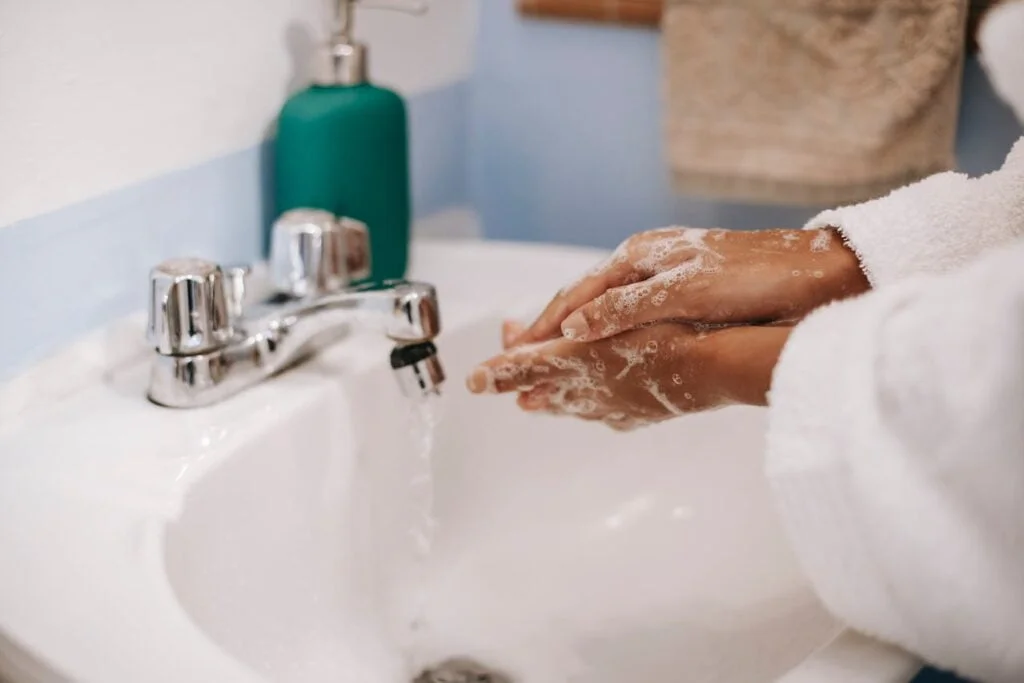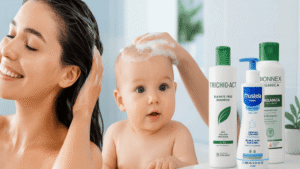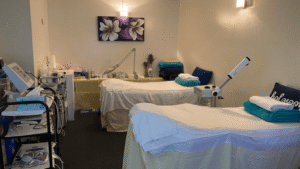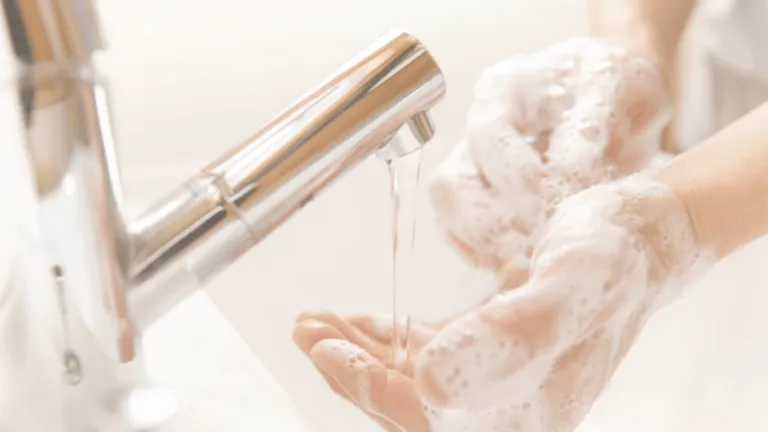Welcome to our article on sanitation and sterilization in the workplace. In order to maintain a hygienic work environment, it is essential to prioritize cleanliness, prevent the spread of pathogens, and eliminate any potential sources of contamination. By implementing effective sanitation and sterilization practices, businesses can create a safe and healthy workspace for their employees and promote overall well-being.
Proper cleaning and sanitizing are crucial steps in preventing foodborne illnesses and ensuring the safety of food preparation areas. By using sanitizers such as chlorine solutions, quaternary solutions, and iodine, the risk of transferring harmful bacteria can be greatly reduced. A well-designed sanitation plan, including a list of cleaning and sanitizing agents and a cleaning schedule, is necessary to maintain a hygienic environment.
Personal hygiene practices also play a vital role in preventing cross-contamination. Regular handwashing is critical for all workers to break the cycle of bacterial transmission. Additionally, proper dishwashing procedures, equipment cleaning, and regular inspections are necessary to ensure a hygienic work environment.
In the following sections of this article, we will delve deeper into the importance of maintaining a hygienic workplace, when and how to effectively disinfect, the role of personal hygiene, the cleaning and sanitizing procedures specific to the food service industry, and more. Let’s explore the key practices and measures that can help maintain a clean and safe work environment for everyone.
Key Takeaways:
- Ensuring a hygienic work environment is crucial for the health and well-being of employees.
- Proper cleaning and sanitizing are essential in preventing foodborne illnesses and reducing the risk of bacterial transfer.
- Regular handwashing and personal hygiene practices help prevent cross-contamination.
- Having a well-designed sanitation plan and following proper cleaning and disinfecting procedures are important.
- Maintaining cleanliness and adhering to the latest cleaning and disinfection standards contribute to a safe work environment.
The Importance of a Hygienic Environment in the Workplace
A hygienic environment is crucial in the workplace to prevent the spread of germs and bacteria that can lead to illness. Maintaining workplace cleanliness through regular cleaning and disinfection is essential for disease prevention and ensuring the well-being of employees and staff.
Cleaning and disinfecting are two distinct processes that work hand in hand to create a hygienic environment. While cleaning involves removing dirt and debris, disinfection specifically targets harmful germs. Professional cleaning services should use effective disinfectant cleaning products to kill germs and ensure a safe and hygienic workplace.
Workers also play an important role in maintaining a hygienic environment. Frequent handwashing is a simple yet powerful practice to prevent the transmission of germs. Proper cleaning practices, such as cleaning and sanitizing shared tools and utensils, help reduce the risk of contamination. Additionally, high-touch surfaces, such as doorknobs and keyboards, should be regularly cleaned and disinfected to minimize the spread of germs.
“A hygienic workplace promotes a healthier and safer working environment.”
Employing a professional cleaning service that is knowledgeable about the latest cleaning and disinfection standards is crucial for ensuring a safe and healthy workplace. By adhering to proper cleaning practices and maintaining a hygienic environment, businesses can minimize the risk of infectious diseases and create a conducive work environment for their employees.
“A hygienic workplace is not only beneficial for employee health, but it also enhances productivity and overall morale.”
When and How to Disinfect
Disinfection plays a critical role in preventing the spread of germs and maintaining a hygienic environment. While regular cleaning is essential, disinfection is necessary, especially in areas where people have been ill or during disease outbreaks. Here are some important guidelines to follow when disinfecting:
- Clean the surface: Before applying a disinfectant, it is important to clean the surface with soap and water to remove any visible dirt or debris. This allows the disinfectant to work more effectively in killing germs.
- Use an EPA-registered disinfectant: Choosing the right disinfectant is crucial. Look for products that are EPA-registered and specifically target the harmful germs you are trying to eliminate. These products have been tested and proven to be effective in killing a wide range of pathogens.
- Follow safety guidelines: When using disinfectants, it is important to follow safety guidelines to protect yourself and others. Increase air circulation by opening windows or using fans, wear recommended protective equipment such as gloves and masks, and ensure that the disinfectant remains on the surface for the recommended contact time.
- Proper storage and use: Safe storage and use of cleaning and disinfection products are essential. Follow the instructions provided on the product label and avoid mixing different products, as this can result in hazardous reactions. Do not apply disinfectants directly to the body or use them in ways not specified by the product label.
It is important to note that not all disinfection methods are recommended for every situation. Methods such as fogging and fumigation should only be used if specified by the product label, as they may have specific safety requirements and may not be suitable for all environments.
By following these guidelines, you can effectively disinfect your workplace and create a safe and hygienic environment for everyone.
The Role of Personal Hygiene in Maintaining a Hygienic Environment
Personal hygiene plays a critical role in maintaining a hygienic environment. Practicing proper hygiene not only promotes cleanliness but also helps prevent the spread of harmful bacteria and cross-contamination. By following basic cleanliness practices and adhering to effective handwashing techniques, workers can contribute to a safe and healthy food service premise
Proper Handwashing
One of the most important personal hygiene practices is proper handwashing. Hands should be washed:
- After sneezing or coughing
- After using the bathroom
- After handling raw foods
- After cleaning or handling dirty surfaces
To ensure effective handwashing, follow these steps:
- Wet your hands with warm water
- Apply soap and lather well
- Scrub your hands for at least 20 seconds, covering all surfaces including the backs of hands, between fingers, and under nails
- Rinse thoroughly with running water
- Dry hands with a clean paper towel
Proper handwashing should be practiced by all workers to break the cycle of bacterial transmission and maintain a hygienic environment.
Cross-Contamination Prevention
Cross-contamination can occur when bacteria from one surface or food item is transferred to another. To prevent cross-contamination, it is important to use separate utensils for different tasks and avoid using the same cloth for cleaning and wiping plates. By implementing these practices, the risk of transferring harmful bacteria is minimized, ensuring a safe food service premise.
Cleanliness Practices
Regular showering, clean hair and clothing contribute to personal hygiene and a clean work environment. Cleanliness practices should be followed by all workers to maintain a hygienic environment. Implementing separate utensils for tasting food and using separate cloths for cleaning and wiping plates can also help prevent cross-contamination.
In conclusion, personal hygiene, particularly proper handwashing, plays a crucial role in maintaining a hygienic environment. By following good hygiene practices and implementing effective cleanliness measures, workers can contribute to a safe and healthy food service premise, reducing the risk of bacterial contamination.
Cleaning and Sanitizing Procedures in Food Service

When it comes to ensuring surface cleanliness and safe food-handling practices in the food service industry, cleaning and sanitizing procedures play a crucial role. While cleaning with soap and detergents effectively removes dirt and grease, sanitizing is necessary to eliminate bacteria and maintain a safe environment.
Commonly used sanitizers in food service establishments include chlorine solutions, quaternary solutions, and iodine. These sanitizers effectively kill bacteria and help prevent the spread of harmful pathogens. However, it’s important to follow proper procedures and guidelines to ensure effective sanitization.
A sanitation plan that includes a list of cleaning and sanitizing agents, as well as a cleaning schedule, is essential for maintaining cleanliness and adherence to food safety regulations. This plan outlines the necessary steps and products to be used for different areas and surfaces within the establishment.
Effective dishwashing procedures are also crucial for safe food handling. Scraping dishes, pre-soaking items with residue, and following specific temperature requirements for washing and sanitizing cycles are necessary steps to ensure thorough cleaning and sanitization. This helps eliminate any potential bacteria and prevent cross-contamination.
Proper equipment cleaning and regular inspections are equally important to prevent bacterial growth and maintain a safe food-handling environment. Regularly cleaning and sanitizing kitchen equipment, utensils, and food preparation surfaces helps eliminate any potential contaminants and reduces the risk of foodborne illnesses.
Overall, adhering to proper cleaning and sanitizing procedures in the food service industry is essential for ensuring surface cleanliness and safe food handling. By following these guidelines, businesses can create a hygienic environment that prioritizes food safety and protects the well-being of customers and employees.
| Benefits of Proper Cleaning and Sanitizing Procedures in Food Service | Importance |
|---|---|
| Minimizes the risk of foodborne illnesses | Prevents harmful bacteria from contaminating food |
| Complies with food safety regulations | Avoids potential penalties and legal issues |
| Promotes customer satisfaction and trust | Enhances reputation and repeat business |
| Maintains a hygienic work environment | Ensures the well-being of employees |
| Reduces the risk of cross-contamination | Prevents the spread of germs and pathogens |
Maintaining a Hygienic Environment in the Workplace
Maintaining a hygienic environment in the workplace is crucial for the health and safety of employees and staff. It ensures a clean and safe space that promotes productivity and well-being. To achieve this, businesses should consider partnering with a professional cleaning service that specializes in maintaining cleanliness and implementing effective disinfection processes.
One of the key aspects of maintaining a hygienic environment is understanding the difference between cleaning and disinfecting. While cleaning removes dirt and debris, disinfection goes a step further by killing germs and reducing the risk of disease transmission. Therefore, it is essential to use appropriate disinfectant cleaning products that are proven to be effective against a broad spectrum of pathogens.
Areas in the workplace that require extra attention include kitchens, dining areas, and restrooms, as they are prone to harboring germs. These spaces should be regularly disinfected to minimize the risk of contamination. Proper cleaning and disinfecting methods should also be followed in high-traffic areas and on frequently touched surfaces such as doorknobs, light switches, and shared equipment.
While professional cleaning services play a vital role in maintaining a hygienic environment, employees can also contribute to the overall cleanliness of the workplace. Encouraging thorough and frequent handwashing, practicing proper cleaning techniques, and regularly sanitizing shared utensils and tools are essential habits to instill.
By prioritizing cleanliness and implementing effective cleaning and disinfection processes, businesses can create a hygienic environment that promotes the well-being and safety of everyone in the workplace.
Benefits of Maintaining a Hygienic Environment in the Workplace:
- Promotes the health and well-being of employees
- Reduces the risk of illness and absenteeism
- Enhances productivity and overall work performance
- Cultivates a positive work culture and employee morale
- Creates a professional and welcoming atmosphere for clients and visitors
In a clean and hygienic work environment, employees can focus on their tasks without worrying about potential health risks. By investing in professional cleaning services and implementing proper disinfection processes, businesses prioritize the health and safety of their workforce, which ultimately contributes to the overall success of the organization.
Hygienic Practices for Workplace Cleanliness
Ensuring workplace cleanliness is a collective effort between professional cleaners and workers. One of the most effective ways to prevent the spread of germs is through frequent handwashing. Placing signs promoting handwashing in restrooms can help raise awareness and encourage proper hygiene practices.
Regularly cleaning and sanitizing shared utensils and cleaning tools is vital to prevent cross-contamination. By implementing a cleaning schedule and checklist for high-touch surfaces, cleaning staff can ensure consistency in cleaning and disinfecting. This proactive approach helps maintain a hygienic environment in the workplace.
It is essential for commercial cleaning services to stay updated with the latest cleaning and disinfection standards to provide effective and proper cleaning. By employing the right techniques and using appropriate cleaning products, professional cleaners contribute to a safe and healthy working environment.
Benefits of Hygienic Practices in the Workplace
Emphasizing workplace cleanliness brings numerous benefits to both employees and the organization as a whole:
- Reduces the risk of illness and absenteeism
- Enhances employee morale and productivity
- Improves the overall image and reputation of the company
- Creates a safe and welcoming environment for customers and visitors
By prioritizing workplace cleanliness and following hygienic practices, businesses can ensure the well-being of their employees and maintain a positive atmosphere.
| Hygienic Practices | Key Steps |
|---|---|
| Frequent Handwashing | Use soap and warm water, scrub for at least 20 seconds, rinse thoroughly, and dry with a clean towel or air dryer. |
| Cleaning and Sanitizing Utensils | Regularly clean and sanitize utensils used for food preparation or shared among employees. |
| High-Touch Surface Cleaning | Establish a checklist or inspection sheet to ensure consistent cleaning and disinfection of high-touch surfaces. |
Ensuring Safe Disinfection Practices
Safe disinfection practices are crucial to prevent harm to individuals and ensure effective disinfection in the workplace. By following proper procedures and guidelines, businesses can maintain a safe and hygienic environment for their employees and staff.
One key aspect of safe disinfection is the use of EPA-registered disinfectants. These disinfectants are specifically formulated to target harmful germs and provide effective sanitization. When choosing a disinfectant, it is important to select one that is registered with the Environmental Protection Agency (EPA) to ensure its safety and efficacy.
Prior to applying the disinfectant, surfaces should be thoroughly cleaned with soap and water to remove any visible dirt or debris. This allows the disinfectant to work more effectively by directly targeting the germs present on the surface.
Safety guidelines should also be followed when using disinfection products. These guidelines may include increasing air circulation in the area being disinfected, using recommended protective equipment such as gloves and masks, and allowing the disinfectant to remain on the surface for the recommended contact time.
Proper storage and use of disinfection products is equally important. It is crucial to label all cleaning and disinfection solutions clearly and store them securely out of reach of children and animals to prevent accidental ingestion or misuse.
Fogging and fumigation methods of disinfection are not recommended unless specifically mentioned on the product label. It is essential to carefully follow the instructions provided by the manufacturer to ensure safe and effective disinfection.
By adhering to these safe disinfection practices, businesses can create a hygienic environment that promotes the well-being of all individuals. Implementing these guidelines not only helps prevent the spread of germs but also ensures the overall cleanliness and safety of the workplace.
| Safe Disinfection Practices | Benefits |
|---|---|
| Use EPA-registered disinfectants | Ensure effective sanitization and targeted germ elimination |
| Clean surfaces before applying disinfectants | Enhance the disinfectant’s efficacy by removing visible dirt and debris |
| Follow safety guidelines | Prevent harm and promote safe disinfection practices |
| Store and use disinfection products properly | Prevent accidental ingestion or misuse |
| Avoid fogging and fumigation methods | Ensure adherence to recommended disinfection practices |
Conclusion
Sanitation and sterilization are vital components in maintaining a hygienic work environment. By regularly cleaning and disinfecting surfaces, practicing proper personal hygiene, and following safe disinfection procedures, businesses can effectively prevent the spread of germs and ensure workplace hygiene. It is crucial for professional cleaning services to stay up-to-date with the latest cleaning and disinfection standards to provide effective and safe cleaning solutions.
By implementing these cleanliness practices, businesses can create a safe and healthy work environment for their employees and staff. Proper sanitation and sterilization not only reduce the risk of contamination and pathogens but also enhance overall workplace hygiene. This helps to promote the well-being and productivity of individuals within the organization.
Remember, a clean and hygienic workplace is essential for preventing the transmission of diseases and maintaining a positive work environment. Investing in sanitation and sterilization measures demonstrates a commitment to employee health and safety. By prioritizing workplace cleanliness, businesses can protect their workforce and contribute to a healthier community.
Frequently Asked Questions (FAQs)
Stay ahead in the fashion game with our latest post on Frequently Asked Questions in fashion blogs.
- Sanitation and sterilization are crucial in preventing the spread of pathogens and maintaining cleanliness in the workplace. These practices help eliminate contamination and ensure a safe and healthy work environment.
- A hygienic environment plays a significant role in preventing the spread of diseases and maintaining workplace cleanliness. By regularly disinfecting high-touch surfaces and implementing proper cleaning procedures, the risk of bacterial transmission can be minimized.
- Disinfection should be done in addition to regular cleaning, especially in areas where people have been ill or during disease outbreaks. EPA-registered disinfectants specific to harmful germs should be used. Surfaces should be cleaned with soap and water before applying the disinfectant and safety guidelines should be followed.
- Personal hygiene practices, such as frequent handwashing and proper cleaning techniques, play a crucial role in preventing cross-contamination and maintaining a hygienic environment. These practices break the cycle of bacterial transmission and ensure a safe food service premise.
- Cleaning and sanitizing are essential procedures in the food service industry to ensure surface cleanliness and safe food-handling practices. Cleaning involves the removal of dirt and grease using soap and detergents, while sanitizing is necessary to kill bacteria. Chlorine solutions, quaternary solutions, and iodine are commonly used sanitizers.
- To maintain a hygienic environment, professional cleaning services should stay updated with the latest cleaning and disinfection standards. Regular disinfection of areas prone to harboring germs, along with proper personal cleaning and disinfecting practices by workers, can contribute to a safe and healthy workplace.
- Safe disinfection practices can be ensured by using EPA-registered disinfectants specific to harmful germs. Surfaces should be cleaned with soap and water before applying the disinfectant. Safety guidelines such as increasing air circulation, using protective equipment, and following proper storage and use of disinfection products should be followed.
- Sanitation and sterilization are essential practices for maintaining workplace hygiene. By implementing proper cleaning, disinfection, and personal hygiene practices, businesses can create a safe and healthy work environment for their employees and staff.


















